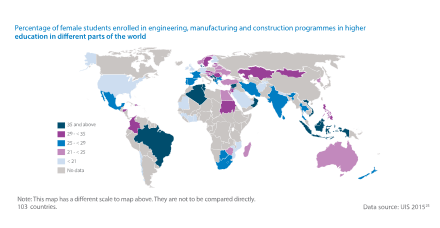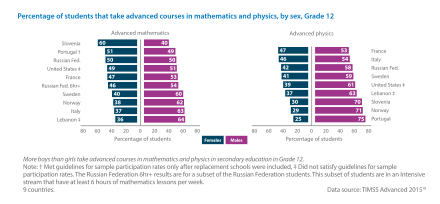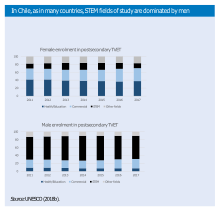Female education in STEM
Female education in STEM includes child and adult female represented in the fields of science, technology, engineering, and mathematics (STEM). In 2017, 33% of students in STEM fields were women.

The organization UNESCO has stated that this gender disparity is due to discrimination, biases, social norms and expectations that influence the quality of education women receive and the subjects they study.[1] UNESCO also believes that having more women in STEM fields is desirable because it would help bring about sustainable development.[1]
Current status of girls and women in STEM education
Overall trends in STEM education

Gender differences in STEM education participation are already visible in early childhood care and education in science- and math-related play, and become more pronounced at higher levels of education. Girls appear to lose interest in STEM subjects with age, particularly between early and late adolescence.[1] This decreased interest affects participation in advanced studies at the secondary level and in higher education.[1] Female students represent 35% of all students enrolled in STEM-related fields of study at this level globally. Differences are also observed by disciplines, with female enrollment lowest in engineering, manufacturing and construction, natural science, mathematics and statistics and ICT fields. Significant regional and country differences in female representation in STEM studies can be observed, though, suggesting the presence of contextual factors affecting girls’ and women's engagement in these fields. Women leave STEM disciplines in disproportionate numbers during their higher education studies, in their transition to the world of work and even in their career cycle.[1][3][4][5][6][7]
Learning achievement in STEM education

Data on gender differences in learning achievement present a complex picture, depending on what is measured (subject, knowledge acquisition against knowledge application), the level of education/age of students, and geographic location. Overall, women's participation has been increasing, but significant regional variations exist. For example, where data are available in Africa, Latin America and the Caribbean, the gender gap is largely in favour of boys in mathematics achievement in secondary education. In contrast, in the Arab States, girls perform better than boys in both subjects in primary and secondary education. As with the data on participation, national and regional variations in data on learning achievement suggest the presence of contextual factors affecting girls’ and women's engagement in these fields. Girls’ achievement seems to be stronger in science than mathematics and where girls do better than boys, the score differential is up to three times higher than where boys do better. Girls tend to outperform boys in certain sub-topics such as biology and chemistry but do less well in physics and earth science.
The gender gap has fallen significantly in science in secondary education among TIMSS trend countries: 14 out of 17 participating countries had no gender gap in science in 2015, compared to only one in 1995. However, the data is less well known outside of these 17 countries. The gender gap in boys' favour is slightly bigger in mathematics but improvements over time in girls’ favour are also observed in certain countries, despite the important regional variations. Gender differences are observed within mathematic sub-topics with girls outperforming boys in topics such as algebra and geometry but doing less well in "number". Girls’ performance is stronger in assessments that measure knowledge acquisition than those measuring knowledge application. Country coverage in terms of data availability is quite limited while data is collected at a different frequency and against different variables in the existing studies. There are large gaps in our knowledge of the situation in low- and middle-income countries in sub-Saharan Africa, Central Asia, and South and West Asia, particularly at the secondary level.[1][4][5][8][9][10][11][12]
Factors influencing girls' and women's participation and achievement in STEM education
According to UNESCO, there are multiple and overlapping factors which influence girls' and women's participation, achievement and progression in STEM studies and careers, all of which interact in complex ways, including:
- Individual level: biological factors that may influence individuals’ abilities, skills, and behaviour such as brain structure and function, hormones, genetics, and cognitive traits like spatial and linguistic skills. It also considers psychological factors, including self-efficacy, interest and motivation.
- Family and peer level: parental beliefs and expectations, parental education and socioeconomic status, and other household factors, as well as peer influences.
- School level: factors within the learning environment, including teachers’ profile, experience, beliefs and expectations, curricula, learning materials and resources, teaching strategies and student teacher interactions, assessment practices and the overall school environment.
- Societal level: social and cultural norms related to gender equality, and gender stereotypes in the media.[1]
Individual level
The question of whether there are differences in cognitive ability between men and women has long been a topic of debate among researchers and scholars. Some studies have found no differences in the neural mechanism of learning based on sex.[1][14][15][16][17]
Loss of interest has been the major reason cited for girls opting out of STEM. However, some have stated that this choice is influenced heavily by the socialization process and stereotyped ideas about gender roles, including stereotypes about gender and STEM. Gender stereotypes that communicate the idea that STEM studies and careers are male domains can negatively affect girls’ interest, engagement, and achievement in STEM and discourage them from pursuing STEM careers. Girls who assimilate such stereotypes have lower levels of self-efficacy and confidence in their ability than boys. Self-efficacy affects both STEM education outcomes and aspirations for STEM careers to a considerable extent. Some studies have shown that girls appear to lose interest in STEM subjects with age.[1][4]
Family and peer level
Parents, including their beliefs and expectations, play an important role in shaping girls’ attitudes towards, and interest in, STEM studies. Parents with traditional beliefs about gender roles and who treat girls and boys unequally can reinforce stereotypes about gender and ability in STEM. Parents can also have a strong influence on girls' STEM participation and learning achievement through the family values, environment, experiences and encouragement that they provide. Some research finds that parents’ expectations, particularly the mother's expectations, have more influence on the higher education and career choices of girls than those of boys. Higher socio-economic status and parental educational qualifications are associated with higher scores in mathematics and science for both girls and boys. Girls’ science performance appears to be more strongly associated with mothers’ higher educational qualifications, and boys’ with their fathers’. Family members with STEM careers can also influence girls’ STEM engagement. The broader socio-cultural context of the family can also play a role. Factors such as ethnicity, the language used at home, immigrant status and family structure may also have an influence on girls’ participation and performance in STEM. Peers can also impact on girls’ motivation and feeling of belonging in STEM education. Influence of female peers is a significant predictor of girls’ interest and confidence in mathematics and science.[8]
School level
Qualified teachers with specialization in STEM can positively influence girls’ performance and engagement with STEM education and their interest in pursuing STEM careers. Female STEM teachers often have stronger benefits for girls, possibly by acting as role models and by helping to dispel stereotypes about sex-based STEM ability. Teachers’ beliefs, attitudes, behaviors and interactions with students, as well as Curricula and learning materials, can all play a role as well. Opportunities for real-life experiences with STEM, including hands-on practice, apprenticeships, career counseling and mentoring can expand girls’ understanding of STEM studies and professions and maintain interest. Assessment processes and tools that are gender-biased or include gender stereotypes may negatively affect girls’ performance in STEM. Girls’ learning outcomes in STEM can also be compromised by psychological factors such as mathematics or test anxiety.[1][4][6][8]
The confidence of a female teacher in STEM subjects also has a strong impact on how well female students will perform in those subjects in the elementary school classroom. For example, female elementary teachers with anxiety around math will negatively affect the achievement of their female students in math.[18] Correlations have been found between gender bias in female elementary students and their achievement in math. Those who had lower achievement over time have also been found to believe that boys are inherently better at math than girls.[18]
A 2018 study found that while girls perform better or equal to boys in two out of three countries, in nearly all countries more girls were qualified to college-level study than had enrolled. Researchers found that female enrolment to STEM subjects was relatively lower in countries with a high degree of gender equality – a gender-equality paradox.[19][20]
Societal level
Cultural and social norms influence girls’ perceptions about their abilities, role in society and career and life aspirations. The degree of gender equality in wider society influences girls’ participation and performance in STEM. In countries with greater gender equality, girls tend to have more positive attitudes and confidence about mathematics and the gender gap in achievement in the subject is smaller. Targeted measures to promote gender equality, such as gender mainstreaming legislation or policies such as quotas, financial incentives or other, can increase girls’ and women's participation in STEM education and careers. Gender stereotypes portrayed in the media are internalized by children and adults and affect the way they see themselves and others. Media can perpetuate or challenge gender stereotypes about STEM abilities and careers.[1] In a study conducted women who took exams with men performed worse than women who took exams with other women. Stereotype threat occurs when the individuals are aware that they may be judged based on a stereotype.[21]
Sources
![]()
References
- Cracking the code: Girls' and womens' education in science, technology, engineering and mathematics (STEM) (PDF). UNESCO. 2017. ISBN 978-92-3-100233-5.
- Mullis, I. V. S., Martin, M. O., Foy, P. and Hooper, M. (2016). "TIMSS Advanced 2015 International Results in Advanced Mathematics and Physics". TIMSS & PIRLS International Study Center website. Archived from the original on 2017-02-15. Retrieved 2 June 2017.CS1 maint: multiple names: authors list (link)
- "STEM and Gender Advancement (SAGA) | United Nations Educational, Scientific and Cultural Organization". www.unesco.org. Retrieved 2017-10-12.
- PISA 2015 Results (Volume I): Excellence and Equity in Education. Paris: OECD. 2016.
- "TIMSS ADVANCED 2015 INTERNATIONAL RESULTS REPORT – TIMSS 2015 INTERNATIONAL RESULTS REPORT". timssandpirls.bc.edu. Retrieved 2017-10-12.
- UIS. "UIS Statistics". data.uis.unesco.org. Retrieved 2017-10-12.
- Science and Engineering Indicators 2014. Arlington: National Science Board. 2014.
- Mullis, I. V. S., Martin, M. O. and Loveless, T. (2016). International Trends in Mathematics and Science Achievement, Curriculum and Instruction. Boston: 20 Years of TIMSS.CS1 maint: multiple names: authors list (link)
- Gender Inequality in Learning Achievement in Primary Education. What can TERCE Tell us?. Santiago: UNESCO. 2016.
- PASEC 2014: Education System Performance in Francophone Sub-Saharan Africa. Dakar: PASEC. 2015.
- Salto, M. (2011). Trends in the Magnitude and Direction of Gender Differences in Learning Outcomes. SACMEQ.
- Fraillon, J., Ainley, J., Schulz, W., Friedman, T. and Gebhardt, E. (2014). Preparing for Life in a Digital Age. The IEA International Computer and Information Literacy Study (ICILS) Report. Melbourne: ICILS and Springer Open.CS1 maint: multiple names: authors list (link)
- Catherine André/VoxEurop/EDJNet; Marzia Bona/OBC Transeuropa/EDJNet (19 April 2018). "The ICT sector is booming. But are women missing out?". Retrieved 27 August 2018.
- Spearman, J. and Watt, H. (2013). "Perception shapes experience: The influence of actual and perceived classroom environment dimensions on girls' motivations for science". Learning Environment Research. 16 (2): 217–238. doi:10.1007/s10984-013-9129-7.CS1 maint: multiple names: authors list (link)
- Kolmos, A., Mejlgaard, N., Haase, S. and Holgaard, J.E. (2013). "Motivational factors, gender and engineering in education". European Journal of Engineering Education. 38 (3): 340–358. Bibcode:2013EJEE...38..340K. doi:10.1080/03043797.2013.794198.CS1 maint: multiple names: authors list (link)
- McDaniel, A. (2015). "The role of cultural contexts in explaining cross-national gender gaps in STEM Expectations". European Sociological Review. 32: 122–133. doi:10.1093/esr/jcv078.
- Su, R., Rounds, J. and Armstrong, P.I. (2009). "Men and things, women and people: A meta-analysis of sex differences in interests". Psychological Bulletin. 135 (6): 859–84. doi:10.1037/a0017364. PMID 19883140.CS1 maint: multiple names: authors list (link)
- Beilock, Sian L.; Gunderson, Elizabeth A.; Ramirez, Gerardo; Levine, Susan C.; Smith, Edward E. (February 5, 2010). "Female Teachers' Math Anxiety Affects Girls' Math Achievement". Proceedings of the National Academy of Sciences. 107 (5): 1860–1863. Bibcode:2010PNAS..107.1860B. doi:10.1073/pnas.0910967107. JSTOR 40536499. PMC 2836676. PMID 20133834.
- G. Stoet, D. C. Geary (14 February 2018). "The Gender-Equality Paradox in Science, Technology, Engineering, and Mathematics Education" (PDF). Psychological Science. 29 (4): 581–593. doi:10.1177/0956797617741719. PMID 29442575.
- "Countries with greater gender equality have a lower percentage of female STEM graduates: Findings could help refine education efforts and policies geared toward girls and science, technology, engineering and mathematics". ScienceDaily. Retrieved 2018-03-14.
- Beasley, Maya (Summer 2012). "Why they leave: the impact of stereotype threat on the attrition of women and minorities from science, math and engineering majors". Social Psychology of Education. 15 (4): 427–448. doi:10.1007/s11218-012-9185-3.
.svg.png)